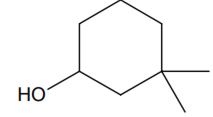 Multiple Choice Questions
Multiple Choice QuestionsReaction of one molecule of HBr with one molecule of 1,3-butadiene at 400 C gives predominantly
3-bromobutene under kinetically controlled conditions
1-bromo-2-butene under thermodymically controlled conditions
3-bromobutene under thermodynamically controlled conditions
3-bromobutene under thermodynamically controlled conditions
Acid catalyzed hydration of alkenes except ethene leads to the formation of
primary alcohol
secondary or tertiary alcohol
mixture of primary and secondary alcohols
mixture of primary and secondary alcohols
The IUPAC name of the compound
3, 3- dimethyl -1- hydroxy cyclohexane
1,1 – dimethyl -3- cyclohexanol
3,3- dimethyl -1- cyclohexanol
3,3- dimethyl -1- cyclohexanol
On mixing ethyl acetate with aqueous sodium chloride, the composition of the resultant solution is
CH3COOC2H5 + NaCl
CH3Cl + C2H5COONa
CH3COCl + C2H5OH + NaOH
CH3COCl + C2H5OH + NaOH
Acetyl bromide reacts with excess of CH3MgI followed by treatment with a saturated solution of NH4Cl given
acetone
acetyl iodide
2- methyl -2- propanol
2- methyl -2- propanol
Which one of the following reduced with zinc and hydrochloric acid to give the corresponding hydrocarbon?
Ethyl acetate
Butan -2-one
Acetamide
Acetamide
Which of the following undergoes reaction with 50% sodium hydroxide solution to give the corresponding alcohol and acid?
Phenol
Benzoic acid
Butanal
Butanal
Phenol reacts with methyl chloroformate in the presence of NaOH to form product A. A reacts with Br2 to form product B. A and B are respectively:




